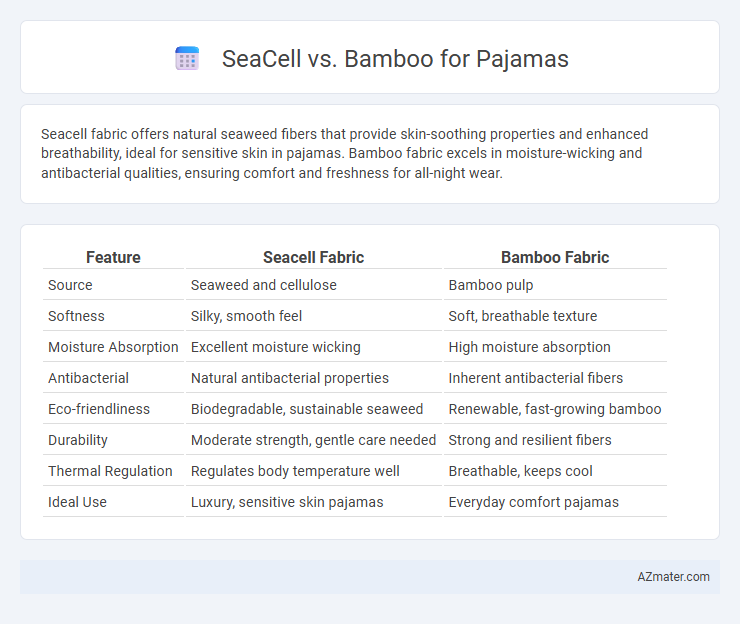Seacell fabric offers natural seaweed fibers that provide skin-soothing properties and enhanced breathability, ideal for sensitive skin in pajamas. Bamboo fabric excels in moisture-wicking and antibacterial qualities, ensuring comfort and freshness for all-night wear.
Table of Comparison
| Feature | Seacell Fabric | Bamboo Fabric |
|---|---|---|
| Source | Seaweed and cellulose | Bamboo pulp |
| Softness | Silky, smooth feel | Soft, breathable texture |
| Moisture Absorption | Excellent moisture wicking | High moisture absorption |
| Antibacterial | Natural antibacterial properties | Inherent antibacterial fibers |
| Eco-friendliness | Biodegradable, sustainable seaweed | Renewable, fast-growing bamboo |
| Durability | Moderate strength, gentle care needed | Strong and resilient fibers |
| Thermal Regulation | Regulates body temperature well | Breathable, keeps cool |
| Ideal Use | Luxury, sensitive skin pajamas | Everyday comfort pajamas |
Introduction to Seacell and Bamboo Fabrics
Seacell fabric is made by infusing cellulose fibers with seaweed, offering natural antibacterial and moisturizing properties ideal for comfortable sleepwear. Bamboo fabric is derived from bamboo pulp, known for its softness, breathability, and moisture-wicking abilities that enhance nighttime comfort. Both fabrics provide eco-friendly options for pajamas, with Seacell emphasizing skin nourishment and Bamboo focusing on temperature regulation.
Origins and Production Processes
Seacell fabric is made by blending sustainably harvested seaweed with cellulose fibers, incorporating marine nutrients into the textile through a patented process that preserves the seaweed's natural properties. Bamboo fabric originates from bamboo grass, processed either mechanically into viscose or lyocell fibers through chemical or solvent-based methods, emphasizing eco-friendly techniques in high-quality production. Both materials emphasize sustainability but differ significantly in raw material sourcing and fiber extraction methods, impacting their softness, breathability, and skin benefits in pajamas.
Environmental Impact and Sustainability
Seacell pajamas are made from seaweed fibers, which are biodegradable and promote ocean sustainability by utilizing renewable marine resources. Bamboo pajamas rely on fast-growing bamboo plants but often involve chemical-intensive processing that can impact the environment negatively. Choosing Seacell over bamboo for pajamas supports lower ecological footprints through natural regeneration and fewer harmful manufacturing practices.
Comfort and Softness Comparison
Seacell pajamas offer exceptional softness due to their infusion of seaweed fibers, which provide a smooth, breathable texture that naturally regulates moisture and enhances comfort. Bamboo pajamas are renowned for their silky feel and high breathability, with moisture-wicking properties that keep skin cool and dry throughout the night. Comparing both, Seacell excels in eco-friendly softness with added skin-nourishing benefits, while bamboo stands out for its lightweight, hypoallergenic comfort ideal for sensitive skin.
Moisture Wicking and Breathability
Seacell pajamas excel in moisture wicking due to their natural seaweed fibers, which efficiently draw sweat away from the skin, keeping you dry and comfortable throughout the night. Bamboo fabric offers superior breathability with its porous structure, allowing excellent airflow to regulate body temperature and reduce overheating. Both materials provide enhanced comfort, but Seacell is particularly effective for moisture management while bamboo prioritizes breathable softness.
Skin Health and Hypoallergenic Properties
Seacell pajamas, infused with seaweed fibers rich in antioxidants and vitamins, promote skin regeneration and combat inflammation, supporting overall skin health. Bamboo fabric is renowned for its natural hypoallergenic and moisture-wicking properties, reducing the risk of irritation and keeping the skin dry and comfortable. Both materials offer breathable, antimicrobial benefits, but Seacell uniquely enhances skin nutrition, while Bamboo excels in softness and allergy resistance.
Durability and Longevity
Seacell pajamas, infused with seaweed fibers, offer moderate durability with natural antibacterial properties that help maintain freshness over time. Bamboo pajamas stand out for exceptional durability due to strong, moisture-wicking fibers that resist wear and pilling even after multiple washes. Choosing bamboo ensures longer-lasting pajamas with sustained softness and resilience suitable for everyday use.
Style and Aesthetic Appeal
Seacell pajamas offer a luxurious sheen and smooth texture derived from seaweed-infused fibers, creating a sophisticated and modern aesthetic ideal for those seeking eco-friendly elegance. Bamboo pajamas showcase a matte finish with a soft, natural drape, appealing to individuals who prefer understated comfort and a more casual, organic look. Both fabrics provide comfortable wear, but Seacell's unique luster enhances style, while bamboo emphasizes breathable softness and relaxed aesthetics.
Price and Accessibility
Seacell pajamas typically command a higher price due to their eco-friendly fabric infused with seaweed nutrients, while bamboo pajamas offer a more budget-friendly option with natural softness and breathability. Bamboo sleepwear is widely accessible in both physical stores and online retailers, making it easy for consumers to find diverse styles. Seacell pajamas, though growing in availability, remain less common and often found in specialty or sustainable fashion outlets.
Which Pajama Fabric Should You Choose?
Seacell pajamas offer exceptional moisture-wicking properties and a soft, silky texture derived from seaweed-infused fibers, making them ideal for sensitive skin and eco-conscious consumers. Bamboo pajamas boast natural antibacterial qualities, breathability, and superior temperature regulation, providing comfort in both warm and cool climates. Choosing between Seacell and Bamboo mainly depends on whether you prioritize sustainability and skin benefits from marine sources or enhanced moisture control and thermo-regulation from plant-based fibers.

Infographic: Seacell vs Bamboo for Pajama
 azmater.com
azmater.com